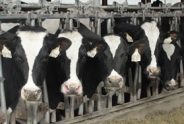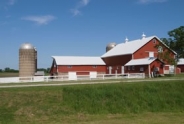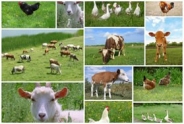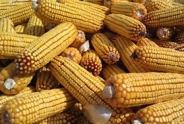It's Time to Rethink Early Breeding of Heifers...Again
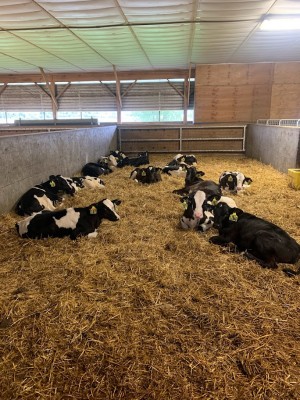
As an industry, we may need to rethink our strategy in pinpointing the ideal time to breed dairy heifers - again.
It wasn't long ago that a new approach in breeding dairy heifers was popular. That strategy was to get heifers into the milking string absolutely as soon as possible, so they could stop costing money and start making money.
While well-intentioned and theoretically sound, veterinarian Gavin Staley believes it may have gone too far. Staley is a dairy reproduction specialist for Diamond V, and shared his thoughts on heifer breeding with the audience of the Dairy Calf and Heifer Association's Annual Conference.
"Yes, it's possible to get heifers pregnant to calve at 21 months," said Staley. "But at this age, they would need to have had an average daily gain (ADG) of 2.05 pounds per day from birth to calving, to achieve the physical maturity necessary for optimal pregnancy and lactation."
What's really happening, said Staley, is that many herds are bringing heifers into the milking string at 21-22 months, even though they have grown at slower rates. He said heifers with an ADG of 1.81 pounds per day up to calving will not be optimally ready to hit lactation until 24 months of age, and those with ADGs of 1.75 pounds per day should not be calved until 25 months. "We are managing heifers to calve at 21 months and growing them to calve at 24 months," said Staley. "That's a serious disconnect."
When first-lactation heifers calve too young for their physical maturity, they have a higher incidence of calving and transition problems, and need to continue channeling nutritional and metabolic resources to growth versus milk production. One pound of gain per day post-calving comes at a commensurate cost of about 7 pounds of milk per day. Staley said it's a deficit they never overcome, even in their second and third lactations. "It's the gift that keeps on giving," he noted.
Staley has observed evidence of this by examining data from hundreds of herds. In one analysis, he found that later-bred heifers (even just one month) gained 60 pounds more per head before becoming pregnant, and subsequently out-produced their earlier-bred herd mates by 3 to 4 pounds of milk per day in their first lactations.
"Over time, immature heifers become a ball and chain on the entire herd," he stated. "Older cows are culled because they are pushed out by heifers entering the milking string, and pretty soon you've got a whole herd of lifetime underperformers. There is a single number that can be highly predictive of a herd's average annual milk production, and that's the 10-week milk production of lactation-1 heifers."
Ironically, Staley said this phenomenon ultimately punishes the herds that do an excellent job of getting their heifers pregnant. "Good reproductive efficiency and immature animals are a toxic combination," he declared.
The issue is further compounded by the use of sexed semen, which creates even more young replacements. In some cases, first-lactation heifers make up half or more of a herd's total population. "It's like having a bunch of college kids who never graduate," said Staley. "You just keep paying the tuition, but they never get a salary."
Staley shared data from one, 3,200-cow herd that delayed its age at first breeding by 40 days, ultimately pushing their first-calving age to about 24 months, instead of 22.5. The results: 7 more pounds of milk per head per day in their first lactations, and a 20% improvement in heifer conception rate. "In addition to achieving higher milk production, they were able to switch to sexed semen as a result of their improved reproductive success," noted Staley.
His advice for hitting the "sweet spot" in heifer-breeding maturity includes:
Every dairy needs a scale. Heifers need to be weighed for both breeding readiness, and at freshening. The ultimate target is to freshen heifers at 85% of their mature weight (soon after/at freshening), or 95% of their mature weight at springing (DCC>260), to accommodate the additional weight of the calf and placenta.
Base breeding decisions on weight and frame size, not age. Weight is the easiest factor to measure. The caveat is that heifers must not be overconditioned, as Staley noted it's easy to make "butterballs." Frame size - and not just height - is more challenging to evaluate, although new technologies are making it more practical to assess. Age can be used to breed heifers, BUT the dairy must be sure the heifer-raising process is delivering a mature heifer at that age.
Focus on heifer growth. Know your average daily gain, and use it to determine your ideal age at first breeding. Efforts to save costs in heifer-raising may impede growth and require later breeding ages.
"Your ultimate goal should be to calve mature animals as early as you can," advised Staley. "But it's the lesser of the two evils to delay breeding."
Upcoming Events
Crops, Cows & Critters - Southwest New York Dairy, Livestock & Field Crops Newsletter Sponsorship
December 19, 2025
Our two forms of publications feature research-based and timely information from our four specialists, listed to the right, along with local event notifications and Cornell University outreach. This information is provided to participants who range from dairy, livestock, and field crops producers to agricultural suppliers and consultants.
Weekly Email Update: Shared with 625+ households who have signed up with our program.
Monthly Paper Mailer: To reach our stakeholders and farmers who lack internet access, we send out a monthly mailer where your company's logo and contact information would be featured with a mailing list of 330+ households.
If you sponsor our weekly and monthly publications you reach approximately 955 households.
Visit our website to view our newsletters!
2025 Cornell Food Beverage & Animal Feed Manufacturer Survey
December 19, 2025
Industry and Educational Advocates for New York State's Food, Beverage, and Animal Feed Manufacturing industries:
As you know, NYS has a diverse food and beverage manufacturing industry, in both the types of industries that exist and the wide distribution of firms by scale. Many manufacturing firms have strong backward linkages to agricultural production sectors in the state that support both farm-level and downstream food industry firms and consumers. In collaboration with the New York State Department of Agriculture and Markets, a team from Cornell University's Charles H. Dyson School of Applied Economics and Management has recently rolled out the 2025 New York State Food, Beverage, and Animal Feed Manufacturer Survey. The industry will benefit from an updated assessment of the industry that informs private and public investments and opportunities to support firm growth and improved profitability.
Cornell Organic Field Crops & Dairy Conference
March 6, 2026
Waterloo, NY
Farmers, researchers, educators, and agricultural service providers from across the Northeast are invited to the 2026 Cornell Organic Field Crops & Dairy Conference, held Friday, March 6, 2026, from 8:00 a.m. to 4:30 p.m. at the Lux Hotel & Conference Center in Waterloo, N.Y.
Co-hosted by New York Soil Health and Cornell CALS, the annual conference brings together leaders in organic grain, dairy, and livestock systems to share practical tools, new research, and farmer-tested strategies to support resilient and profitable organic production.
Announcements
No announcements at this time.


